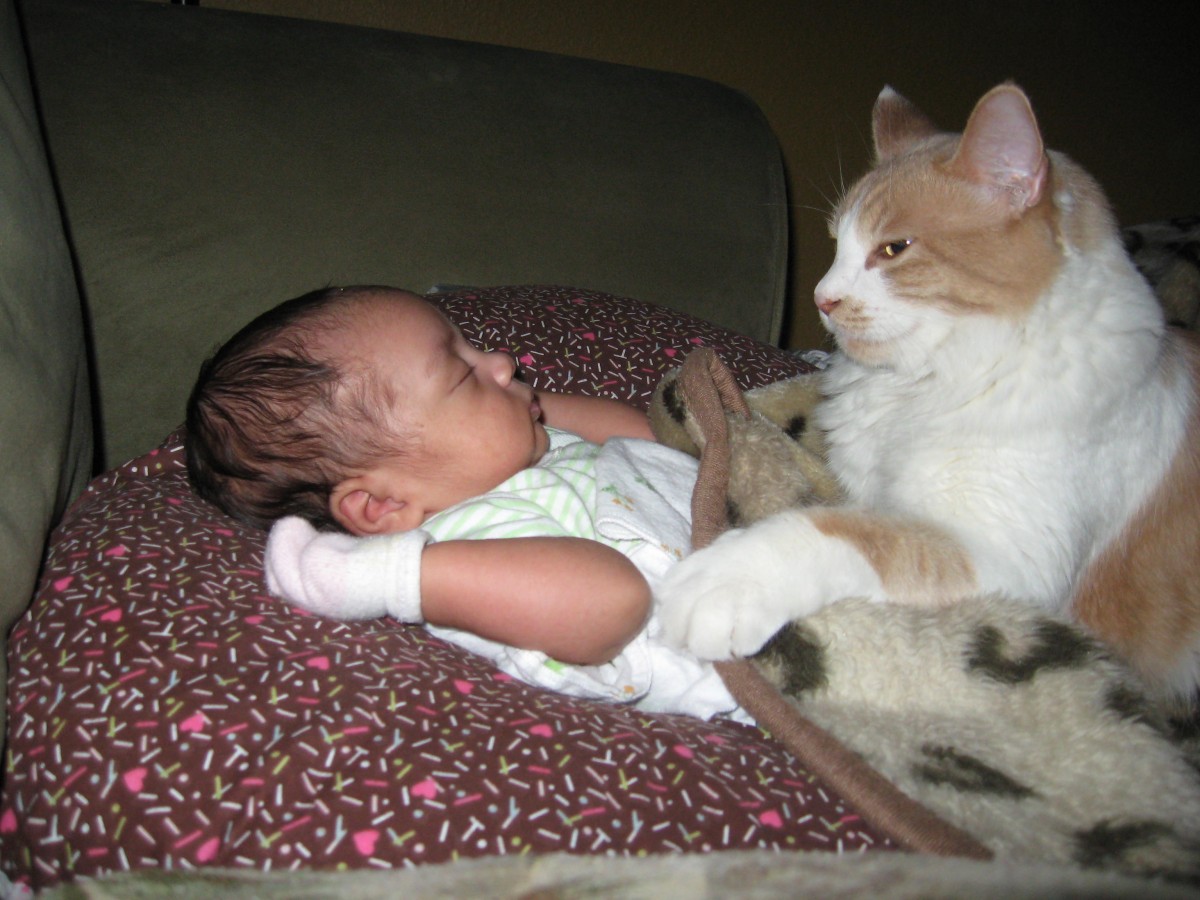
Cat and Baby: Tips for a Successful Cohabitation
Contents
– Cat and baby: questions to ask yourself during pregnancy
– Baby’s arrival: monitoring the cat’s health
– Baby’s room: does the cat have access?
– Preparing your cat for baby’s arrival
– Baby’s arrival: precautions to take
– Cohabiting with your baby
Your family will grow, and your living space will shrink to accommodate baby. It will be the time of visits from family, friends, and the nanny; the time to reorganize the house’s spaces, schedules, and routines. In short, many upheavals await you, and everyone, including your cat, will have to find their balance!
Follow our advice for a perfect cohabitation of your cat and baby.
Cat and baby: questions to ask yourself during pregnancy

It is better to agree with your partner on the future organization before baby’s arrival. This will prevent your cat from feeling any tension that may arise in the couple otherwise.
These questions should be asked before or during the pregnancy:
– The baby’s arrival will require a new organization of your schedule and workload. Will you be able to cope with all these tasks without neglecting your cat’s hygiene and well-being?
– Are you ready to budget for a cat: new treats, a heated basket, mattress, toys, a pheromone diffuser, cat flap?
– Will you need to hire a live-in nanny? If a third party is caring for your baby while you’re away, consider checking their affinity for cats and making sure they’ll respect your house rules with the cat.
– Do you share the same ideas about parenting? Will the baby sleep in her room or yours? Will the cat’s place in the family and in the home change?
– If your baby is allergic to cat hair, for your child’s health and your cat’s well-being, will you consider moving to a larger space or adopting your cat?
Good to know: if you live in a small apartment with a shy, aggressive, or behaviorally challenged cat, there is a very high probability that the baby/cat cohabitation will not go well.
Baby’s arrival: monitoring the cat’s health
There’s no question of forgetting about vaccinations, deworming, and flea control. No more neglecting daily litter box cleaning and general hygiene. Make good resolutions as soon as you get pregnant.
A healthy cat will be happier and less stressed. Consider a medical checkup, especially if your cat is older. Joint pain, impaired vision or hearing, and any disease affecting the nervous system can make a cat more anxious and defensive.
Baby’s room: does the cat have access?
It’s common knowledge that cats like cleanliness, comfort, calm, and warmth. The baby’s room is the epitome of a cat’s pleasure, so she’ll be interested in it. Be prepared! Decide whether or not the cat will have access to the nursery. There are no rules; it’s a matter of choice and conviction.
You can let the cat have access to the room if:
– the cat feels comfortable with the baby;
– your cat is curious, friendly, and active;
– you easily forget to close the doors;
– there is no other room in the house that can match the comfort of the baby’s room;
– your cat is healthy.
Lock the baby’s room as soon as you are pregnant if:
– your cat is messy and urine-marking;
– you do not want the cat to be in contact with the baby;
– the cat has shown aggressive behavior in the past that you found incomprehensible and unpredictable.
Good to know: try to set up a place that is safe from the baby’s comings and goings (once he or she grows up) and loud screams. Don’t yell at the cat if it accidentally wanders into the baby’s room. Don’t try to catch him. Just keep the door wide open and let him go.
Preparing the cat before the baby arrives
To reduce the anxiety that the changes will cause, here are our recommendations:
– Take the time, well before baby arrives, to establish the new routines that will be the order of the day.
– Let your cat inspect all the new objects that may be cluttering up his territory: stroller, bassinet, playpen, etc., and put them away in the place they will occupy in the house from now on.
– Experiment with the baby monitor and noisy toys.
– Try to reduce the intensity and frequency of your interactions if you have a very strong emotional relationship with your cat: don’t make your cat depends on your love and teach her to grow up with more play than petting
– Don’t allow your cat in your room for at least a month if you’ve been sleeping with him or her until now but have decided that when the baby arrives, that’s over.
– Bring the dirty baby clothes from the hospital and let the cat sniff them.
Good to know: If you want to know how your cat is likely to react to a newborn, you can invite friends who have a baby. If your cat runs away, it will probably respond similarly to your baby. This experience gives you time to work out solutions if you live in an apartment. For cats with access to the garden, no problem, they will avoid the house during the day.
Baby’s arrival: precautions to take
The intrusion is a disturbing moment. The normal and probable reaction of the cat is that it is frightened, that it blows, and that it flees. This behavior can last a long time, from a few weeks to months, even years.
– Young cats under 10 months of age are quicker to accept a baby. The more cuddly and friendly your cat is, the easier and quicker this will be.
– Adult males may mark territory with urine sprays on baby’s things. Try pheromone diffusers, but there are no guarantees.
Here are the guidelines to follow:
– Remain indifferent to the cat’s behavior and, above all, give the cat control over its choice. Do not pet the cat; speak to it in a normal tone of voice, and leave the doors open so that it can escape the presence of the baby, which is likely.
– If it shows interest, hold the baby and let the cat sniff the baby’s things, bassinet, and blanket first. Observe his body language.
– Don’t add anything new: avoid visits that day.
Also, some dangerous behaviors should be avoided. Therefore:
– Never force the contact: forbid to take the cat in your arms to show him the baby.
– Forget selfies and souvenirs. No photos or selfies of the cat with the baby.
– Do not intervene if your cat blows. Move away from him calmly without reprimanding him.
– Do not try to reassure your cat by petting it and showing it the baby.
All of these actions can result in defensive aggression if the cat feels unsafe or redirected aggression if the intrusion upsets the cat. You risk getting bitten and losing the cat’s trust. As long as the cat is irritated by the situation, do not touch it.
Cohabitating with your baby
You’ll probably receive quite a few gifts, so let the cat play with the wrappings, exploring the new things without being on the alert. Take the initiative for interactions (moments of tenderness, games, treats with snacks) in the absence of baby (during his naps, in the evening, or outside the house). Don’t force anything, and be patient.
As your baby grows and begins to move, you’ll need to be more present and not leave him unsupervised. Unintentionally, his behavior can be anxiety-provoking for your cat, especially if he hasn’t accepted the newborn.
Finally, a visit to the veterinarian will protect the baby from parasites. Your vigilance and well-applied routines will avoid confusion and accidents, but there will still be the possibility of an allergy problem. Decide with your allergist how to proceed.





